The Intel Kaby Lake-X i7 7740X and i5 7640X Review: The New Single-Threaded Champion, OC to 5GHz
by Ian Cutress on July 24, 2017 8:30 AM EST- Posted in
- CPUs
- Intel
- Kaby Lake
- X299
- Basin Falls
- Kaby Lake-X
- i7-7740X
- i5-7640X
The Fastest for Serial Workloads
If you asked ‘what made the best processor’ fifteen years ago, the obvious answers were performance, power and price. As time has marched on, this list has started to include integrated graphics, bandwidth, platform integration, platform upgradability, core-to-core latency, and of course, cores. Marching up from a single x86 core through to CPUs that carry 10 cores for consumers, 28 cores for enterprise and 72 cores for add-in cards makes the task of creating a perfect processor almost impossible – there is no way to satisfy all of the properties that build a processor today. Both AMD and Intel start from basic building blocks (a single core) and then configure processors around that core, adding in more cores, connectivity, and then binning to the right voltage/frequency and pricing appropriately. The end result is a stack of processors aimed at different segments of the market.
The pair of Kaby Lake-X processors cover one main area listed above more than any others: core performance. By having the latest CPU microarchitecture and placing it on the newest high-end desktop platform there is room at the top for more frequency leading to a higher pure performance product. As a byproduct these CPUs are power efficient, leading to a high performance per watt, and are situated in a platform with extensive IO options. Ultimately this is where the Kaby Lake-X customer will sit: someone who wants high single thread performance but is not after massive multi-core performance. This would typically cover the majority of gamers and enthusiasts, but not necessarily content creators.
The benefits in the benchmarks are clear against the nearest competition: these are the fastest CPUs to open a complex PDF, at the top for office work, and at the top for most web interactions by a noticeable amount.
The downsides are pure throughput workflows, such as neuron simulation, rendering and non-video encoding.
The parts in the middle are the ones to dissect, and these get interesting. Let me pull up a few graphs that illustrate this middle of the road position: Chromium Compilation, Agisoft Photoscan and WinRAR.
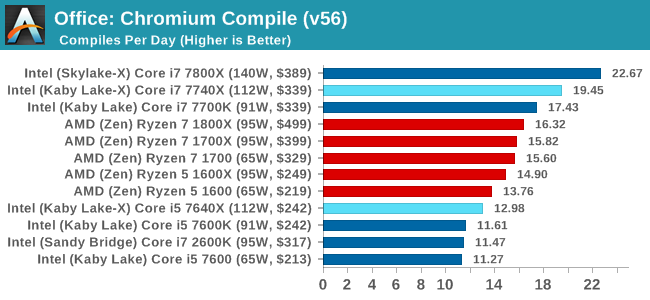
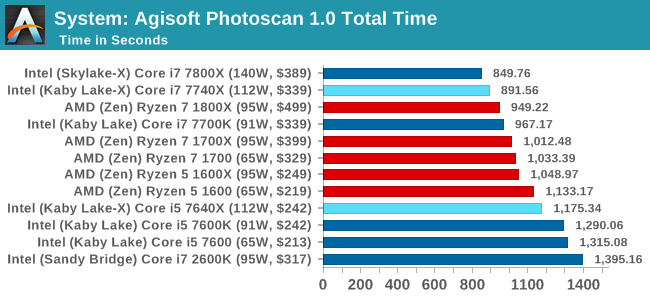
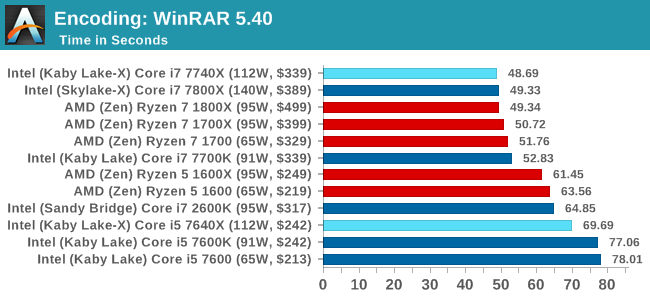
These three results show the Core i7-7740X performing above any AMD chips of similar price, but the Core i5-7640X performing below any Ryzen 7 or Ryzen 5 parts. This comes down to the workload in each of these benchmarks, and how the processor configurations affect that. All three of these real-world benchmarks are variable-thread workloads. Some elements are serialized and rely on a high single-thread performance, while other elements are fully parallelizable and can take advantage of cores and threads (sometimes threads do not necessarily help). The benchmarks are ultimately limited by Amdahl’s Law, where single thread speed affects the whole test, but multiple-threads only helps the parallelizable parts. With sufficiently parallelizable code, it becomes a balance between the two.
So for the Core i7-7740X, up against the Ryzen 7 1700 at an equivalent price, the Core i7 has eight threads and the Ryzen 7 has sixteen, but the Core i7 has a much higher single thread performance. So for these benchmarks, having a high performance metric like this means that despite having half the cores/threads of the AMD part, the Core i7 can take the lead very easily.
But the Core i5-7640X has a different task. It has four cores, like the Core i7, but no hyperthreading, so it sits at four threads. Its direct competitor, the Ryzen 5 1600X, has six cores with simultaneous multithreading, leading to twelve threads. This gives the AMD processor a 3:1 advantage in threads, and for each of these three benchmarks it can parallelize the code sufficiently that the single thread performance of the Intel CPU is not enough. Moving from a 2:1 ratio with the Core i7 to a 3:1 ratio with the Core i5 is a turning point for ST performance compared to MT performance.
So with the X299 confusion, are these CPUs worth recommending?
When Kaby Lake-X first came out, a number of technology experts were confused at Intel’s plans. It made sense to launch the latest microarchitecture on the high-end desktop platform, although launching it in a quad-core form was an idea out-of-left-field, especially for a platform that is geared towards multiple cores, more memory, and more memory bandwidth. In that paradigm, the Kaby Lake-X is an oddball processor design choice.
There are bigger factors at play however – if Intel launched 6-10 core parts on KBL, it would cannibalize their Skylake-X and Skylake-SP sales. Also, as we’ve seen with Skylake-X CPUs, those enterprise cores are now different to the consumer Skylake-S cores, with different cache structures and AVX-512. So if Intel had launched >4 cores on KBL-X, they would have likely had to scrap Skylake-X.
But that’s a slight tangent.
The Core i7-7740X appeals to users who want the fastest out-of-the-box single thread x86 processor on the market today. This means financial traders, gamers, and professionals working with serial code bases, or anyone with deep pockets that might think about upgrading to Skylake-X in the future. Enthusiast overclockers are likely to find the better binned CPUs fun as well.
That’s if you do not mind paying a premium for the X299 platform. For users who mind the cost, the Core i7-7700K is 98% of the way there on performance but can save a hundred dollars on the motherboard and offers the same functionality. In some of our benchmarks, where despite the high single thread performance having more cores helped, then spending a little more on the Skylake-X six-core Core i7-7800X is beneficial: for example, Luxmark and POV-Ray scored +33% for the 7800X over the 7740X.
The Core i7-7740X makes certain sense for a number of niche scenarios. By contrast, the Core i5-7640X doesn’t make much sense at all. There’s still the benefit of high single-thread performance and some good gaming performance in older titles, but in the variable threaded workloads it loses to AMD’s processors, sometimes by as much as 45%. For a chip that comes in at $242, users should expect to pay about the same on a motherboard – whereas either an AMD part or the Core i5-7600K can go in a $120 motherboard and still be overclocked.
There are only two scenarios I can see where the Core i5 adds up. Firstly, users who just want to get onto X299 now and upgrade to a bigger CPU for quad-channel memory and more PCIe lanes later. The second is for professionals that know that their code cannot take advantage of hyperthreading and are happy with the performance. Perhaps in light of a hyperthreading bug (which is severely limited to minor niche edge cases), Intel felt a non-HT version was required.
In our recent CPU Buyers’ Guide (link autoupdates to the latest CPU guide) we suggested the Core i7-7740X for anyone wanting a Peak VR experience, and we still stand by that statement. It has enough threads and the biggest grunt to take on VR and the majority of enthusiast gaming experiences, if a user has pockets big enough.
The recommendations of the new CPUs boil down to platform costs. They seem a minor upgrade to the Kaby Lake-K processors and the Z270 platform, which is a platform that caters to a big audience with a more cost-sensitive structure for motherboards in mind.


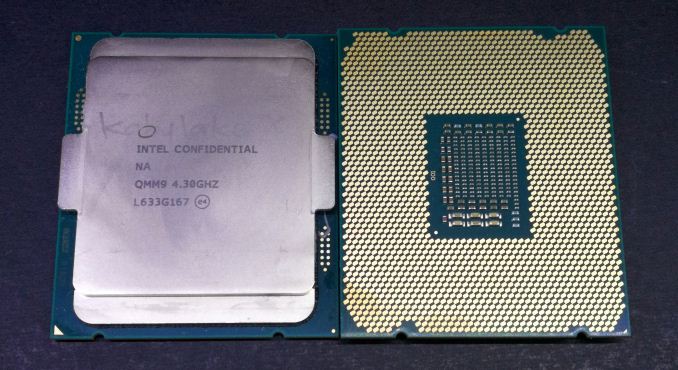
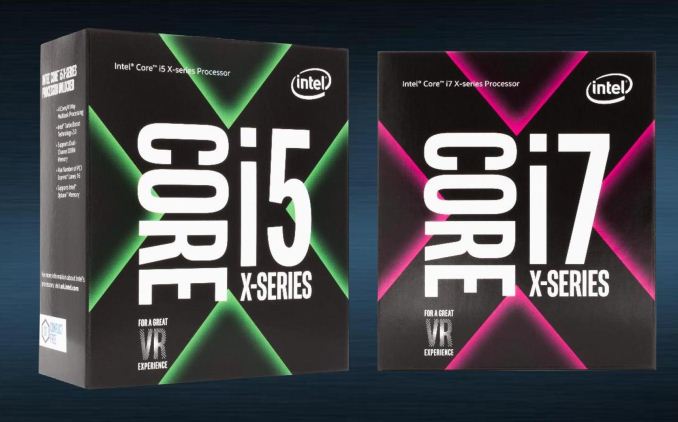








176 Comments
View All Comments
Santoval - Tuesday, July 25, 2017 - link
That is not how IPC works, since it explicitly refers to single core - single thread performance. As the number of cores rises the performance of a *single* task never scales linearly because there is always some single thread code involved (Amdahl's law). For example if your task has 90% parallel and 10% serial code its performance will max out at x10 that of a single core at ~512 cores. From then on even if you had a CPU with infinite cores you couldn't extract half an ounce of additional performance. If your code was 95% parallel the performance of your task would plateau at x20. For that though you would need ~2048 cores. And so on.Of course Amdahl's law does not provide a complete picture. It assumes, for example, that your task and its code will remain fixed no matter how many cores you add on them. And it disregards the possibility of computing distinct tasks in parallel on separate cores. That's where Gustafson's Law comes in. This "law" is not concerned with speeding up the performance of tasks but computing larger and more complex tasks at the same amount of time.
An example given in Wikipedia involves boot times : Amdahl's law states that you can speed up the boot process, assuming it can be made largely parallel, up to a certain number of cores. Beyond that -when you become limited by the serial code of your bootloader- adding more cores does not help. Gustafson's law, on the contrary, states that instead of speeding up the boot process by adding more cores and computing resources, you could add colorful GUIs, increase the resolution etc, while keeping the boot time largely the same. This idea could be applied to many -but not all- computing tasks, for example ray tracing (for more photorealistic renderings) and video encoding (for smaller files or videos with better quality), and many other heavily multi-threaded tasks.
Rickyxds - Monday, July 24, 2017 - link
I just agree XD.Diji1 - Wednesday, July 26, 2017 - link
"Overall speed increase 240%."LMAO. Ridiculous.
Alistair - Wednesday, July 26, 2017 - link
No reason to laugh. I compared the 6600k vs the Ryzen 1700. 1 year speed increase of 144 percent (2.44 times the speed). Same as this: 1135 vs 466 points.http://cpu.userbenchmark.com/Compare/Intel-Core-i5...
Dr. Swag - Tuesday, July 25, 2017 - link
I disagree, best value is 1600 as it oces as well as 1600x, comes with a decent stock cooler, and is cheaper.vext - Monday, July 24, 2017 - link
Interesting article but it seems intended to play down the extremely bad press x299 has received which is all over the internet and Youtube.Once you get past Mr. Cuttress' glowing review, it's clear that the I5-7640x is not worth the money because of lackluster performance, the I7-7740X is marginally faster than the older 7700k, and the I7-7800x is regularly beaten by the 7740X in many benchmarks that actually count and is a monstrously inefficient energy pig. Therefore the only Intel CPUs of this batch worth buying are the 7700k/7740x, and there is no real advantage to x299. In summary, it doesn't actually change anything.
It's very telling that Mr. Cutress doesn't comment on the absolutely egregious energy consumption of the 7800x. The Test Bed setup section doesn't list the 7800x at all. The 7840x and 7740x are using a Thermalright True Copper (great choice!) but no info on the 7800x cooler. Essentially, the 7800x cameo appearance is only to challenge the extremely strong Ryzen multi-threaded results, but its negative aspects are not discussed, perhaps because it might frighten people from x299. Tsk, tsk. As my 11 year old daughter would say "No Fair." By the way, the 7800x is selling for ~ $1060 right now on Newegg, not $389.
Proudly typed on my Ryzen 1800x/Gigabyte AB350 Gaming 3. # ;-)
Ian Cutress - Monday, July 24, 2017 - link
You may not have realised but this is the Kaby Lake-X review, so it focuses on the KBL-X parts. We already have a Skylake-X review for you to mull over. There are links on the first page.mapesdhs - Monday, July 24, 2017 - link
Nevertheless, the wider picture is relevant here. The X299 platform is a mess. Intel is aiming KL-X at a market which doesn't exist, they've locked out features that actually make it useful, it's more power hungry, and a consumer needs a lot of patience and plenty of coffee to work out what the heck works and what doesn't on a mbd with a KL-X fitted.This is *exactly* the sort of criticism of Intel which should have been much stronger in the tech journalism space when Intel started pulling these sorts of stunts back with the core-crippled 3930K, heat-crazy IB and PCIe-crippled 5820K. Instead, except for a few exceptions, the tech world has been way too forgiving of Intel's treading-on-water attitude ever since SB, and now they've panicked in response to Ryzen and released a total hodgebodge of a chipset and CPU lineup which makes no sense at all. And if you get any disagreement about what I've said by anyone at Intel, just wave a 4820K in their face and say well explain this then (quad-core chip with 40 PCIe lanes, da daa!).
I've been a big fan of Z68 and X79, but nothing about Intel's current lineup appeals in the slightest.
serendip - Tuesday, July 25, 2017 - link
There's also the funny bit about motherboards potentially killing KBL-X CPUs if a Skylake-X was used previously.What's with Intel's insane product segmentation strategy with all the crippling and inconsistent motherboard choices? It's like they want to make it hard to choose, so buyers either get the cheapest or most expensive chip.
Haawser - Tuesday, July 25, 2017 - link
'EmergencyLake-X' is just generally embarrassing. Intel should just find a nearby landfill site and quietly bury it.